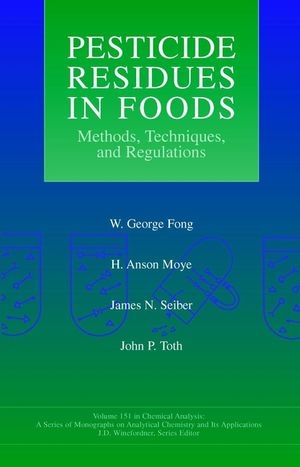
Pesticide Residues in Foods
Wiley-Interscience (Verlag)
978-0-471-57400-2 (ISBN)
Advances in analytical chemistry methodology now allow us to detect the most minute trace amounts of pesticides. As this capacity grows, so does public concern about toxic contamination, resulting in stricter government regulations and a growing demand for even more sensitive, precise, and reliable analysis.
Addressing the interplay between regulations and the development of analytical technology, this volume presents the first unified treatment of the regulatory and analytical aspects of pesticide residues. Current regulations, existing and emerging methodologies, state-of-the-art instrumentation, and the basic science of analyzing for pesticides in food and other environmental media are all covered.
The book provides step-by-step guidelines to analytical techniques, along with real-world examples from the latest research-showing the reader how to analyze minute traces of pesticides quickly and accurately, using both highly sophisticated and basic, less sensitive techniques. Many safety issues are explored in depth, as are the regulatory aspects of pesticide registration, residue analysis, exposure monitoring, risk assessment, and tolerance enforcement.
Timely, authoritative, and practical throughout, Pesticide Residues in Foods is an invaluable reference for analytical chemists and laboratory managers everywhere-in industry, agriculture, environmental sciences, research, and instrument manufacturing-and for anyone with an interest in the broader environmental, agricultural, and consumer-related implications of pesticide use.
An invaluable resource for analytical chemists and laboratory managers, Pesticide Residues in Foods provides a complete overview of the theory, practice, and regulatory aspects of pesticide residue analysis today, including:
* All regulatory issues, from risk assessment and tolerance to data-quality requirements to laboratory accreditation standards
* State-of-the-art methodologies and instrumentation, including high- performance liquid chromatography and mass spectrometry
* The application of analytical technology to "green chemistry," such as the reduction of solvents and toxic reagents in the laboratory
* Novel solutions to the old problem of keeping the food supply safe from harmful levels of pesticides
* Ample examples to help analytical chemists select the most appropriate method for a given residue analysis
* Easy-to-use tables and figures throughout the text
W. GEORGE FONG, a widely recognized expert in the pesticide residue field, is the Environmental Administrator of the Florida Department of Agriculture. His published work includes the chapter on toxicology in the Encyclopedia of Chemical Technology, Fourth Edition, available from Wiley. H. ANSON MOYE is Professor in the Food Science and Human Nutrition Department at the University of Florida. He has published numerous papers and articles in a career that spans nearly three decades. JAMES N. SEIBER is Director of the Center for Environmental Sciences and Engineering at the University of Nevada in Reno. Dr. Seiber is the coeditor of Fumigants: Environmental Fate, Exposures, and Analysis and Treatment and Disposal of Pesticide Wastes. JOHN P. TOTH is Coordinator of the mass spectrometry facility at the University of Florida's Institute of Food and Agricultural Sciences. Among others, his research interests include the application of mass spectrometry to pesticide residue analysis.
The Analytical Approach (J. Seiber).
Extraction, Cleanup, and Fractionation Methods (J. Seiber).
Determination Methods (J. Seiber).
Mass Spectrometry (J. Toth).
Emerging Methods: Extractions and Cleanup (H. Moye).
Enzyme-Linked Immunosorbent Assay (Elisa) (H. Moye).
Regulatory Aspects: Pesticide Registration, Risk Assessment and Tolerance, Residue Analysis and Monitoring (W. Fong).
Appendix.
Index.
| Erscheint lt. Verlag | 18.2.1999 |
|---|---|
| Reihe/Serie | A Wiley-Interscience Publication | Chemical Analysis ; Vol.151 |
| Sprache | englisch |
| Maße | 160 x 232 mm |
| Gewicht | 628 g |
| Themenwelt | Studium ► Querschnittsbereiche ► Prävention / Gesundheitsförderung |
| Naturwissenschaften ► Biologie ► Biochemie | |
| Naturwissenschaften ► Chemie | |
| Recht / Steuern ► EU / Internationales Recht | |
| Recht / Steuern ► Privatrecht / Bürgerliches Recht ► Medizinrecht | |
| Weitere Fachgebiete ► Land- / Forstwirtschaft / Fischerei | |
| ISBN-10 | 0-471-57400-7 / 0471574007 |
| ISBN-13 | 978-0-471-57400-2 / 9780471574002 |
| Zustand | Neuware |
| Haben Sie eine Frage zum Produkt? |
aus dem Bereich


